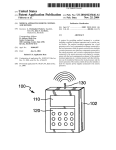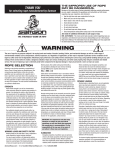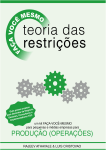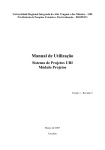Download ELP-EPI001
Transcript
accura-expRACE KIT [!kjur"-ikspré(i)s] El Plain Institute Revolutionary Tools for Continual Discovery For Research Use Only Not for use in diagnostic or therapeutic procedures. Code No. EPI001 Lot No. 0001 Storage –20℃ 1 Contents I. Kit Components 3 A. First-Strand cDNA Synthesis 3 B. Second-Strand cDNA Synthesis 3 C. Other Reagents 3 D. RACE PCR 4 II. Other Materials Required 4 III. First-Strand cDNA Synthesis 4 IV. Second-Strand cDNA Synthesis 5 V. Rapid Amplification of cDNA Ends (RACE) 7 A. RACE PCR 8 B. Cloning and DNA Sequencing 8 C. How to Use Control mTfrc 5ʼ and 3ʼ RACE Primers 9 D. Example of RACE PCR and RT-PCR Experiments Using Control Primers 10 E. Procedure for Obtaining Longer cDNA by RACE 11 VI. Troubleshooting 12 A. ds cDNA Synthesis 12 B. RACE 12 C. RACE of Rare Transcripts 12 D. Accidental Amplification of the Genomic DNA 13 VII. Significant Advantages of the Single-Primer RACE Method and Its Applications 13 VIII. Conclusion 14 IX. References 14 2 User Manual This kit contains reagents for five double-stranded (ds) cDNA synthesis reactions and control primers for 5ʼ and 3ʼ RACE PCR. A thermostable DNA polymerase for PCR is not included in the kit. Preparation of poly(A)+ RNA is required*. I. Kit Components A. First-Strand cDNA Synthesis 1. 100 μl 5X RTase (Reverse Transcriptase) Buffer 250 mM Tris-HCl, pH 8.3 375 mM KCl 15 mM MgCl2 2. 10 μl Oligo(dT)20 Primer (10 μM) 3. 5.5 μl M-MLV (Moloney Murine Leukemia Virus) Reverse Transcriptase (Advanced Type) (50 U/μl) Source: An E. coli strain carrying a recombinant plasmid B. Second-Strand cDNA Synthesis 4. 200 μl 5X Second-Strand Synthesis Buffer 100 mM Tris-HCl, pH 7.5 500 mM KCl 25 mM MgCl2 50 mM (NH4)2SO4 (Ammonium Sulfate) 5 mM Dithiothreitol (DTT) 0.25 mg/ml Bovine Serum Albumin (BSA) 0.75 mM β-Nicotinamide Adenine Dinucleotide (β-NAD) 5. 5.5 μl E. coli RNase H (1 U/μl) Source: An E. coli strain carrying a recombinant plasmid 6. 5.5 μl E. coli DNA ligase (5 U/μl) Source: An E. coli strain carrying a recombinant plasmid 7. 11 μl E. coli DNA polymerase I (12 U/μl) Source: An E. coli strain carrying a recombinant plasmid 8. 300 μl EDTA (0.5 M EDTA, pH 8.0) C. Other Reagents 9. 40 μl 10 mM dNTP Mix (10 mM each of dATP, dCTP, dGTP, dTTP) 10. 500 μl 7.5 M Ammonium Acetate 11. 1.7 ml Distilled Water, Deionized, Sterile 12. 1.6 ml TE, pH 8.0 10 mM Tris-HCl (pH 8.0) 1 mM EDTA (pH 8.0) *BioMag® mRNA Purification Kit (Polysciences), NucleoTrap® mRNA (MACHEREY-NAGEL), FastTrack® 2.0 mRNA Isolation Kit + (Life Technologies), Absolutely mRNA Purification Kit (Agilent Technologies), etc. can be used for preparation of poly(A) RNA. 3 D. RACE PCR Control 5ʼ and 3ʼ RACE Primers 13. 200 μl Mouse Transferrin Receptor (Tfrc) 5ʼ RACE Primer (10 pmol/μl): 5ʼ-TTCTCAGGTGGCAGCTTTGAACT-3ʼ 14. 200 μl (Tm 62.58℃) Mouse Transferrin Receptor (Tfrc) 3ʼ RACE Primer (10 pmol/μl): 5ʼ-CGTGGAGACTACTTCCGTGCTAC-3ʼ (Tm 62.55℃) (Full-length cDNA ~4.9 kb) Note: Kit components are arranged in a row from left to right according to the approximate order of use in an experiment. II. Other Materials Required 1. Thermostable DNA polymerase for PCR (PrimeSTAR (TaKaRa), KOD (TOYOBO), Pfu (Thermo Fisher Scientific), Phusion (New England Biolabs), etc.) 2. Phenol (TE, pH 8.0 saturated) 3. 95% Ethanol 4. 75% Ethanol 5. TE, pH 8.0 III. First-Strand cDNA Synthesis This procedure is a method for synthesizing first-strand cDNA by the use of an advanced type M-MLV (Moloney Murine Leukemia Virus) Reverse Transcriptase. Because this enzyme has very high extension ability, it can effectively synthesize long first-strand cDNA. Even if the RNA, which tends to form a large secondary structure, is used as a template, this enzyme is able to synthesize the first-strand cDNA efficiently at the usual reverse-transcription temperature (42℃). This enzyme is suitable for the synthesis of long cDNA and construction of a cDNA library containing a high proportion of full-length cDNA. Conditions of First-Strand cDNA Synthesis Reaction ─────────────────────────── 5X RTase Buffer 2 μl 10 mM dNTP 1 μl 10 μM oligo(dT)20 1 μl poly(A)+ RNA 1 μg (1-5 μl) M-MLV RTase (Advanced Type) (50 U/μl) 1 μl Distilled water Total volume (4-0) μl 10 μl ─────────────────────────── 1. poly(A)+ RNA, oligo(dT)20 primer, and distilled water should be thawed on ice. 4 A sterile 0.5 ml microcentrifuge tube should be precooled on ice. 5X RT buffer and 10 mM dNTP mix should also be thawed on ice. 2. Add 1 μg of poly(A)+ RNA(1-5 μl)and 1 μl of oligo(dT)20 primer into a sterile 0.5 ml microcentrifuge tube. 3. Add distilled water to a volume of 6 μl. 4. Mix gently by pipetting and then spin down the contents in the microcentrifuge at 4℃. 5. Incubate the tube at 70℃ for 3 min. 6. Immediately cool the tube on ice for 3 min. 7. Briefly spin down the contents in a microcentrifuge at 4℃. 8. Add the following to a reaction tube: 5X RTase Buffer 2 μl 10 mM dNTP 1 μl M-MLV RTase (Advanced Type) (50 U/μl) Total volume 1 μl 10 μl 9. Mix gently by pipetting. 10. Briefly spin down the contents in a microcentrifuge at 4℃. 11. Incubate the tube at 42℃ for 1 hr. 12. Cool the tube on ice for 2~3 min. 13. Perform second-strand synthesis continuously in the same tube. IV. Second-Strand cDNA Synthesis Second-strand cDNA synthesis is performed in the same reaction tube as first-strand synthesis. E. coli RNase H, E. coli DNA polymerase I, and E. coli DNA ligase degrade the RNA of RNA-DNA hybrids and synthesize second-strand cDNA (1, 2). The treatment of ds cDNA with T4 DNA polymerase is not necessary with this kit because an adaptor or an anchor ligation is not necessary for the next RACE experiment. The RACE experiment can be performed as soon as the second-strand cDNA synthesis is finished. 1. 5X Second-strand buffer, dNTP mix, and sterile water should be thawed on ice. 2. Add the following into the first-strand reaction tube: (First-Strand Mixture 10 μl) Distilled water 48.4 μl 5X Second-Strand Buffer dNTP Mix (10 mM) 16 μl 1.6 μl Mix by vortexing and add enzymes. E. coli RNase H 1U 1 μl E. coli DNA ligase 5U 1 μl E. coli DNA polymerase I 24U 2 μl Total volume 80 μl 3. Mix gently by pipetting. 4. Briefly spin down the contents in a microcentrifuge at 4℃. 5. Incubate the tube at 16℃ for 1.5 hr. 5 6. Add 1.6 μl of 0.5 M EDTA (pH 8.0) to stop the reaction. 7. Add 80 μl of TE-saturated phenol (pH 8.0) and vortex thoroughly. 8. Spin the tube at maximum speed in a microcentrifuge for 10 min at room temperature. 9. Transfer the aqueous phase to a sterile 0.5 ml microcentrifuge tube. 10. Add 29 μl of 7.5 M ammonium acetate (final concentration, 2 M). 11. Add 2.5 volumes of 95% ethanol (272.5 μl) and mix thoroughly. 12. Place the tube at –20℃ for 1 hr. 13. Spin the tube at maximum speed in a microcentrifuge for 20 min at 4℃. 14. Carefully remove the supernatant. 15. Add 400 μl of prechilled 75% ethanol at –20℃. 16. Spin the tube at maximum speed in a microcentrifuge for 5 min at 4℃. 17. Carefully remove the supernatant. 18. Dry the pellet for 5~10 min. 19. Dissolve the pellet in 10 μl TE, pH 8.0. 20. Dilute 1 μl of ds cDNA with 250-500 μl of TE, pH 8.0 to a concentration of 0.2~0.4 μg/ml. Instead of monitoring cDNA synthesis by labeling with [α-32P]dCTP, you can check an aliquot (1 μl) of ds cDNA products (10 μl TE, pH 8.0 solution) by agarose gel electrophoresis (Figure 1). 1 2 M Figure 1. Result of ds cDNA Synthesis ds cDNA synthesis was performed using mouse testis poly(A)+ RNA. 1 μl of ds cDNA (#19 on page 5) was used for 1% agarose gel electrophoresis. Lanes 1, 2: Different kits were used. Lane M: HindIII-digested λ DNA. Anticipated Results It is expected that 0.2~1 μg of ds cDNA will be obtained from 1 μg of poly(A)+ RNA. 6 V. Rapid Amplification of cDNA Ends (RACE) (3, 4) In RACE PCR by the single-primer method*1 using this kit, an adaptor primer or an anchor primer is not used. The targeted cDNA is amplified with only a gene-specific primer (5). The basis for its mechanism (Figure 2) is that the terminal region of the ds DNA is partially denatured at 68℃ for the extension reaction as is observed at the cohesive end of the λ phage and that the linear DNA molecule tends to be circular (6, 7, 8). Upon reaching the 5ʼ end of the template DNA under these circumstances, a thermostable DNA polymerase switches the template to the 5ʼ terminal region on the newly synthesized daughter strand at a certain probability*2. The DNA polymerase continues synthesizing DNA sequences complementary to the gene-specific primer, occasionally adding several nucleotides from the 3ʼ flanking sequence. Using this daughter strand as a template, the targeted cDNA is accurately amplified by PCR using only a gene-specific primer. It is through this process that the resultant cDNA likely obtains its characteristic terminal inverted repeat (9, 10, 11, 12, 13) (Figure 2. legend). *1 The single-primer method is covered by U.S. patent No. 7504240 and Japanese patent No. 4304350. *2 The exact frequency is currently unknown. It is assumed that the frequency is different according to the size of the DNA fragments. It is also assumed that it is different according to the thermostable DNA polymerase used. 1st cycle! denature !! 3 � 5 annealing! gene-specific primer! synthesis! 3 � 3 end! 3 end synthesis by! template switching of ! Taq DNA polymerase! 2nd cycle! 5 end! sequences complementary! template DNA! to a gene-specific primer! denature! annealing! synthesis! Figure 2. Possible Mechanism of RACE Reactions Using a Single Gene-Specific Primer. The template-switching event probably occurs at a variety of positions. However, the length of the terminal inverted repeat falls in the range of 24-34 bp in every obtained cDNA clone (1 and data not shown). Possible reasons for this fact are as follows. A region that dissociates from dsDNA by heat denaturation may be limited within the first 40 bp or less at the DNA end at 68℃. The length of denaturation might also depend on the GC content. In addition, only the cDNA having the nucleotide sequence perfectly complementary to the gene-specific primer (24 bases) is then selectively amplified in the subsequent cycles of PCR. These factors are thought to cause predominant amplification of cDNA having terminal inverted repeat of 24-34 bp. Complementary DNA, which has a terminal inverted repeat structure comprising a gene-specific primer with or without several nucleotides adjacent to its 3ʼ end, is made (amplified) by the proposed mechanism described above. 7 By using the ds cDNA synthesized by this kit as a template for PCR, both 5ʼ RACE and 3ʼ RACE can be performed. A. RACE PCR RACE PCR can easily be performed under the condition such as RT-PCR. Generally, complicated modifications such as hot-start PCR, touchdown PCR and stepdown PCR are not necessary. Recommended Tm is 60℃-65℃. We recommend that the composition of the reaction mix and the condition of thermal cycling are prepared according to the instruction of manufacturer of thermostable DNA polymerase. Cycling is needed 5 to 10 times more than that of RT-PCR. A longer extension time tends to increase the chance for template-switching of thermostable DNA polymerase (systematic studies have not yet been done: see *2 on page 7). Therefore, we recommend that RACE PCR be performed for 1-2 minutes longer than that of RT-PCR. Example For 50 μl PCR, mix the following reagents: Distilled water 29 μl 10X PCR Buffer 5 μl Gene-Specific (RACE) Primer (10 pmol/μl) 5 μl 2 mM dNTP 5 μl ds cDNA 5 μl (1-2 ng) Thermostable DNA polymerase (1 U/μl) 1 μl Total volume 50 μl Start thermal cycling using the following parameters*: 94℃ 2 min 98℃ 10 sec Tm℃ 68℃ 30 sec 35~40 cycles 4 min * PCR should be performed under the conditions described in the instructions used for thermostable DNA polymerase. To characterize RACE products, 5~10 μl of the reaction mix is examined by agarose gel electrophoresis. B. Cloning and DNA Sequencing It is necessary that RACE PCR products be cloned to a TA cloning vector and confirmed by DNA sequencing. To perform direct DNA sequencing to confirm RACE PCR products, another gene-specific primer is required. For 5ʼ RACE products, a primer of 3ʼ distal region to a 5ʼ RACE primer is required. For 3ʼ RACE 8 products, a primer of 3ʼ distal region to a 3ʼ RACE primer is required. =>====================================<= 5ʼ RACE product !! ! Sequencing primer (ds cDNA) ! 5ʼ RACE primer C. How to Use Control mTfrc 5ʼ and 3ʼ RACE Primers If you cannot detect the RACE product in several experiments, performing a RACE experiment using control mTfrc 5ʼ and 3ʼ RACE primers and synthesized ds cDNA may help solve the problem. At first, using both primers, perform RT-PCR of the mTfrc for detecting the product of ~2.3 kb. Next, perform RACE using a control mTfrc 5ʼ or 3ʼ RACE primer under the same conditions as RT-PCR except for thermal cycling time. For RACE, set the thermal cycling 5 to 10 more times than that of RT-PCR. As mentioned above, a longer extension time tends to increase the chance of template-switching of thermostable DNA polymerase. We recommend that RACE PCR be performed with 1-2 minutes longer extension time than that for RT-PCR. If you can use these control experiments to determine the appropriate conditioning procedure of RACE PCR, you will easily perform RACE experiments for various targeted genes. mTfrc cDNA ============================================ 4920 bp -> <- 3ʼ RACE primer 5ʼ RACE primer 2109-2131 4358-4380 if you failed to obtain the desired results in these control experiment, it is presumed that there is a problem with the prepared total RNA or poly(A)+ RNA or synthesized ds cDNA. In that case, confirm where the problem is by performing agarose gel electrophoresis of the prepared total RNA or poly(A)+ RNA or synthesized ds cDNA. Depending on the circumstances, total RNA or poly(A)+ RNA may have to be prepared again. See VI. A. Note: If the synthesized ds cDNA is not derived from mouse, perform the experiment described above using control primers (e.g., TFR, β-actin, etc.) of the organism under study. 9 D. Example of RACE PCR and RT-PCR Experiments Using Control Primers Using mouse testis synthesized ds cDNAs above (Figure 1; Lanes 1 and 2, 1/250 diluted) and control mTfrc RACE primers contained in this kit, we performed 5ʼ RACE and RT-PCR experiments. We used KOD -Plus- Neo DNA polymerase (TOYOBO; not available in the US) and prepared the reaction mix under the thermal cycling conditions listed below. ・RACE PCR ───────────────────────── Distilled water 26 μl 10X PCR Buffer 5 μl Tfrc 5ʼ RACE Primer (10 pmol/μl) 5 μl 2 mM dNTP 5 μl 25 mM MgSO4 3 μl ds cDNA 5 μl KOD -Plus- Neo (1 U/μl) 1 μl Total volume 50 μl ───────────────────────── ・RT-PCR ───────────────────────── Distilled water 28 μl 10X PCR Buffer 5 μl Tfrc 3ʼ RACE Primer (10 pmol/μl) forward 1.5 μl Tfrc 5ʼ RACE Primer (10 pmol/μl) reverse 1.5 μl 2 mM dNTP 5 μl 25 mM MgSO4 3 μl ds cDNA 5 μl KOD -Plus- Neo (1 U/μl) 1 μl Total volume 50 μl ───────────────────────── Thermal Cycling 94℃ 2 min 98℃ 10 sec 63℃ 30 sec 68℃ 4 min 40 cycles To characterize 5ʼ RACE and RT-PCR products, 10 μl and 2 μl of the reaction mix, respectively, are examined by agarose gel electrophoresis. As shown in Figure 3, 5ʼ RACE products of ~4.4 kb, ~3 kb, ~2.4 kb, etc. (Lanes 2~11) and RT-PCR product of ~2.3 kb (Lane 1) were observed. Shown are some of the results of three 5ʼ RACE experiments. 10 The RACE products are observed in more than half of the tubes (4 tubes were used in an experiment). The ratio of obtained RACE product is thought to fluctuate according to the targeted gene. The amount of RACE product is much less than that of RT-PCR. The reason for this is presumed to be that the template of single-primer RACE, in which template-switching has occurred appropriately, is limited to one or a few molecules in the initial few cycles of PCR. In the case of 5ʼ RACE, several bands will be observed when template-switching has occurred in several cDNAs of different sizes. In the case of 3ʼ RACE, the product size is generally identical. 1 M 2 3 4 5 6 7 8 9 10 11 Figure 3. Results of 5ʼ RACE and RT-PCR. Lane 1: RT-PCR. Lane M: HindIII-digested λ DNA. Lanes 2~11: 5ʼ RACE PCR. Lanes 2~5: Results of a single RACE experiment. Lane 6: Extension time set to 8 min; cDNA was diluted 10-fold. Lanes 7, 8: Extension time set to 4 min; cDNA was diluted 2- and 5-fold, respectively. Lane 9: Same conditions as above. Lanes 10, 11: Extension time set to 4 min; cDNA was diluted 2-fold. In general, the first RACE experiment is performed at the Tm temperature of the RACE primer(s). If any of the RACE products cannot be observed, we suggest that the RACE experiment be performed at an annealing temperature of 1-2℃ lower. To observe nonspecific products, we suggest that the RACE experiment be performed at an annealing temperature of 1-2℃ higher. A RACE product that becomes almost a single band is likely to be the true product. This is the key to successful RACE experiments. Generally, if the designed PCR primer is appropriate for the RACE experiment, you may expect to obtain good results at or near the Tm temperature. E. Procedure for Obtaining Longer cDNA by RACE Long cDNA can be amplified using the single-primer RACE method. However, in general, short DNA molecules tend to circularize more efficiently than do long DNA molecules. When long target cDNA and short target cDNA are present in the same reaction mix, the short cDNA is more apt to be amplified by the single-primer RACE method. Therefore, it becomes easy to get long cDNA by performing the following manipulations. Synthesized ds cDNA is fractionated by agarose gel electrophoresis. The agarose gel block containing high molecular weight cDNA is cut out and eluted by electroelution (14, 15) or by use of a commercially available DNA 11 elution kit. The eluted cDNA is resuspended in an appropriate volume of TE, pH 8.0 and used for RACE experiments. The probability for synthesizing a long template for single-primer RACE increases by setting the extension time to 8~10 min in the initial few PCR cycles. Residual cycles are done at 4 min of extension time. The probability observing several RACE product bands may also increase. There have been no problems when the PCR extension time is set to 8 min in all PCR cycles, as shown in Lane 6 of Figure 3. VI. Troubleshooting A. ds cDNA Synthesis If high quality poly(A)+ RNA is obtained, ds cDNA synthesis is successful. Before preparing poly(A)+ RNA, examine the quality of the prepared total RNA by performing agarose gel electrophoresis using a portion of the prepared total RNA. If rRNA (28S RNA and 18S RNA) and tRNA(+5S rRNA) are not degraded, high quality poly(A)+ RNA can be prepared from this total RNA. About 1% of total RNA is collected as poly(A)+ RNA (14). It is important to measure the concentration of prepared poly(A)+ RNA. Although it is not always necessary to use 1 μg of poly(A)+ RNA for cDNA synthesis, in that case it is necessary to change the dilution rate of ds cDNA by TE, pH 8.0. To raise the accuracy of the RACE experiments, we recommend performing cDNA synthesis whenever possible after determining the concentration of poly(A)+ RNA (a simple method may be used (15A)). B. RACE If you cannot obtain a good result of RACE through several replications of experiments, for example amplifying nonspecific products or amplifying no product, attempt the next modification. [ 1 ] If excessive non-specific products were observed, reduce ds cDNA for RACE PCR to 1/2, 1/5, or 1/10, etc. [ 2 ] If no product was observed, increase ds cDNA for RACE PCR to 2-, 3-, or 5-fold, etc. [ 3 ] If undesirable results were obtained, change the amount of a gene-specific primer used for RACE PCR. Generally, reduce a gene-specific primer. These modifications should produce good results. If a nonspecific product is amplified after these modifications, try to perform the hot-start method or touchdown PCR. This might improve the RACE results. C. RACE of Rare Transcripts If the content of the target cDNA contained in the ds cDNA synthesized by this kit is very low, the RACE product might not be observed by agarose gel electrophoresis. In that case, we recommend that a second round of PCR be carried out under the same condition using 5-10 μl of the first-round sample. In this experiment, the RACE product may then be observed by agarose gel electrophoresis. As with “V. E. Procedure for Obtaining Longer cDNA by RACE,” prolonging the extension time of the initial few PCR cycles to 8~10 min increases the probability of synthesizing a rare template for the single-primer RACE. 12 D. Accidental Amplification of the Genomic DNA The efficiency of the single-primer method of RACE is very high. If the targeted cDNA is not in the synthesized cDNAs, the targeted gene present in a very small amount of genomic DNA contaminated through the preparation of poly(A)+ RNA is often amplified by PCR. This problem is avoided by the treatment of poly(A)+ RNA or total RNA with RNase-free DNase. Poly(A)+ RNA or total RNA treated by RNase-free DNase should be extracted with phenol and precipitated with ethanol. Alternatively, genomic DNA-free total RNA can be prepared by commercially available columns for RNA preparation capable of DNase treatment. If the exon-intron structure of the targeted gene is already known, this problem is solved by designing a RACE primer spanning an exon-exon junction. VII. Significant Advantages of the Single-Primer RACE Method and Its Applications [ 1 ] Both 5' and 3' RACE can be done with the same cDNA. [ 2 ] Simple PCR protocols without complicated modifications are available for efficient RACE. [ 3 ] Because long cDNA can be obtained, the method is suitable for searching splicing variants of many genes. Short cDNA can be obtained more efficiently than a longer one. [ 4 ] Once double-stranded cDNA is synthesized, it can be used as a cDNA library without adaptor ligation or cloning into a ! phage vector. [ 5 ] Only a single gene-specific primer is necessary for screening a cDNA library using RACE PCR. [ 6 ] Using the recombinant DNA method, full-length cDNA can easily be obtained from 5ʼ and 3ʼ RACE products. [ 7 ] T4 DNA polymerase treatment for creating blunt ends on ds cDNA and ligation of an adaptor or an anchor DNA are not necessary for cDNA library construction. Specifically, the efficiency of T4 DNA polymerase treatment and ligation does not influence a library size. Therefore, cDNA derived from rare mRNA (16, 17) can efficiently be isolated (18, 19). [ 8 ] By using this RACE kit, full-length cDNA can be isolated from short RNA sequence information based on Expressed Sequence Tag (EST) (20), Serial Analysis of Gene Expression (SAGE) (21), or Differential Display (22) analysis, enabling investigation of its detailed characteristics. [ 9 ] By using this RACE kit, microRNA (pri-miRNA) (23) and lncRNA (24, 25) can be isolated and their characteristics analyzed. Detection is possible from analyses of [ 8 ]. [ 10 ] Amplification of genomic DNA of various organisms can be performed using the single-primer method. The single-primer method is especially useful for identifying gene-occurred insertional mutation by rescuing a DNA element used for insertional mutagenesis. The single-primer method can also be used to identify the insertion site of the vector DNA used for creating transgenic organisms including cells. 13 VIII. Conclusion It is expected that almost all existing cDNAs can be amplified by performing RACE experiments under various reaction conditions and with various primers using the accura-expRACE KIT. Then, they can be cloned. IX. References 1. Okayama, H. & Berg, P. (1982) High-efficiency cloning of full-length cDNA. Mol. Cell. Biol. 2, 161-170. 2. Gubler, U. & Hoffman, B.J.(1983) A simple and very effective method for generating cDNA libraries. Gene 25, 263-269. 3. Frohman, M.A., Dush, M.K. & Martin, G.R. (1988) Rapid production of full-length cDNAs from rare transcripts: amplification using a single gene-specific oligonucleotide primer. Proc. Natl. Acad. Sci. USA 85, 8998-9002. 4. Chenchik, A., Diachenko, L., Moqadam, F., Tarabykin, V., Lukyanov, S. & Siebert, P.D. (1996) Full-length cDNA cloning and determination of mRNA 5' and 3' ends by amplification of adaptor-ligated cDNA. BioTechniques 21, 526-534. 5. Hirano, M. (2004) RACE using only a gene-specific primer: application of a template-switching model. Mol. Biotechnol. 27, 179-186. 6. Levene, S.D. & Crothers, D.M. (1986) Ring closure probabilities for DNA fragments by Monte Carlo simulation. J. Mol. Biol. 189, 61-72. 7. Cloutier, T.E. & Widom, J. (2004) Spontaneous sharp bending of double-stranded DNA. Molec. Cell 14, 355-362. 8. Du, Q., Smith, C., Shiffeldrim, N., Vologodskaia, M. & Vologodskii, A. (2005) Cyclization of short DNA fragments and bending fluctuations of the double helix. Proc. Natl. Acad. Sci. USA 102, 5397-5402. 9. Panganiban, A. T. & Temin, H. M. (1983) The terminal nucleotides of retrovirus DNA are required for integration but not virus production. Nature 306, 155–160. 10. Wang, K. & Pearson, G. D. (1985) Adenovirus sequences required for replication in vivo. Nucleic Acids Res. 13, 5173–5187. 11. Olasz, F., Farkas, T., Kiss, J., Arini, A., & Arber, W. (1997) Terminal inverted repeats of insertion sequence IS30 serve as targets for transposition. J. Bacteriol. 179, 7551–7558. 12. Calvi, B. R., Hong, T. J., Findley, S. D., & Gelbart, W. M. (1991) Evidence for a common evolutionary origin of inverted repeat transposons in Drosophila and plants: hobo, Activator, and Tam3. Cell 66, 465–471. 13. Morgan, G. T. (1995) Identification in the human genome of mobile elements spread by DNA-mediated transposition. J. Mol. Biol. 254, 1–5. 14. Ausubel, F.M., Brent, R., Kingston, R.E., Moore, D.D., Seidman, J.G., Smith, J. A. & Struhl, K. (Eds) (1994) Current Protocols in Molecular Biology. John Wiley & Sons, Inc., New York. 15. Sambrook, J., Fritsch, E.F. & Maniatis, T. (1989) Molecular Cloning: A Laboratory Manual, 2nd ed. Cold Spring Harbor Laboratory Press, Cold Spring Harbor, New York. 16. Kapranov, P., Cheng, J., Dike, S., Nix, D.A., Duttagupta, R., Willingham, A.T., Stadler, P.F., Hertel, J., Hackermüller, J., Hofacker, I.L., Bell, I, Cheung, E., Drenkow, J., Dumais, E., Patel, S., Helt, G., Ganesh, M., Ghosh, S., Piccolboni, A., Sementchenko, V., Tammana, H. & Gingeras, T.R. (2007) RNA maps reveal new RNA classes and a possible function for pervasive transcription. Science 316, 1484-1488. 17. Mercer, T.R., Gerhardt, D.J., Dinger, M.E., Crawford, J., Trapnell, C., Jeddeloh, J.A., Mattick, J.S. & Rinn, J.L. (2012) Targeted RNA sequencing reveals the deep complexity of the human transcriptome. Nature Biotechnol. 30, 99–104. 18. Hirano, M. & Noda, T., (2004) Genomic organization of the mouse Msh4 gene producing bicistronic, chimeric and antisense mRNA. Gene 342, 165-177. 14 19. Hirano, M. (2008) Natural Grp78 antisense RNA induces apoptosis by creating a chimeric mRNA with Msh4 pre-mRNA. In A. G. Hernandes, (Ed), Antisense Elements (Genetics) Research Focus, (pp 27-69), Nova Science Publishers, Inc., New York. 20. Sikela, J.M. & Auffray, C. (1993) Finding new genes faster than ever. Nature Genet. 3, 189-191. 21. Velculescu, V.E., Zhang, L., Vogelstein, B., & Kinzler, K.W. (1995) Serial analysis of gene expression. Science 270, 484-487. 22. Liang, P. & Pardee, A. (1992) Differential display of eukaryotic messenger RNA by means of the polymerase chain reaction. Science 257, 967-970. 23. Yates, L.A., Norbury, C.J. & Gilbert, R.J.C. (2013) Long and short of microRNA. Cell 153, 516-519. 24. Numata, K., Kanai, A., Saito, R., Kondo, S., Adachi, J., Wilming, L.G., Hume, D.A., Hayashizaki, Y. & Tomita, M. (2003) Identification of putative noncoding RNAs among the RIKEN mouse full-length cDNA collection. Genome Res. 13, 1301-1306. 25. Nam, J-.W. & Bartel, D.P. (2012) Long noncoding RNAs in C. elegans. Genome Res. 22, 2529-2540. 15 Note: After this kit is used, the box found inside can be used as a tube stand. If you have any questions or any opinions about the accura-expRACE KIT, please contact us by email at: [email protected] Technical Support Email: [email protected] El Plain Institute products may not be resold, modified for resale, or used to manufacture commercial products without written approval of El Plain Institute. A company name or a brand name mentioned in this manual is a trade name of each company, or a registered or unregistered trademark, and these belong to each owner. The single-primer method is covered by U.S. Patent #7,504,240 and Japanese Patent #4,304,350. © 2013, El Plain Institute Inc. All rights reserved. El Plain Institute Inc. 1-12-2 Hanakawado, Taito-ku Tokyo 111-0033, Japan Email: [email protected] 16
































